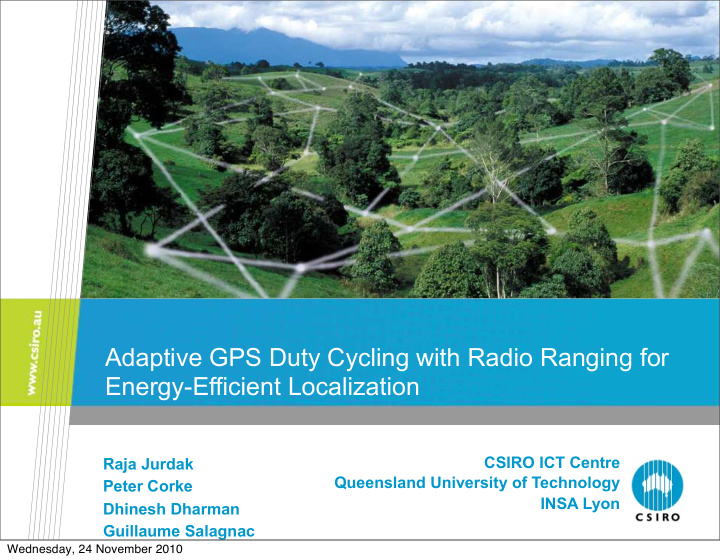



Adaptive GPS Duty Cycling with Radio Ranging for Energy-Efficient Localization CSIRO ICT Centre Raja Jurdak Queensland University of Technology Peter Corke INSA Lyon Dhinesh Dharman Guillaume Salagnac Wednesday, 24 November 2010
Motivation Wednesday, 24 November 2010
Motivation Wednesday, 24 November 2010
Motivation • Localization systems need absolute position references • GPS Wednesday, 24 November 2010
Motivation • Localization systems need absolute position references • GPS • GPS is energy-expensive Wednesday, 24 November 2010
Motivation • Localization systems need absolute position references • GPS • GPS is energy-expensive • Key ideas of this work • Duty cycle GPS • Complement with energy- inexpensive signals • Radio beacons • Accelerometers • Magnetometers Wednesday, 24 November 2010
Motivation • Localization systems need absolute position references • GPS • GPS is energy-expensive • Key ideas of this work • Duty cycle GPS • Complement with energy- inexpensive signals • Radio beacons • Accelerometers • Magnetometers Wednesday, 24 November 2010
Cattle sensor networks • Domain problems: • Herd behaviour • Grazing patterns • Social interaction GPS + RF antennas Wednesday, 24 November 2010
Virtual Fencing: Environmental protection Wednesday, 24 November 2010
Virtual Fencing: Environmental protection Wednesday, 24 November 2010
Design Considerations GPS lock times loosely depend on off time Wednesday, 24 November 2010
Design Considerations GPS lock times loosely Cows are slow! depend on off time Wednesday, 24 November 2010
GPS Duty Cycling 1. GPS acquires lock X X Assumed position GPS chip uncertainty Real position Uncertainty Wednesday, 24 November 2010
GPS Duty Cycling 1. GPS acquires lock X X Assumed position GPS chip uncertainty Real position Uncertainty AAU Wednesday, 24 November 2010
GPS Duty Cycling 2. GPS powered off X X Assumed position Real position Uncertainty AAU Wednesday, 24 November 2010
GPS Duty Cycling 4. GPS turns on prior to reaching AAU X X Assumed position Real position Uncertainty AAU Wednesday, 24 November 2010
GPS Duty Cycling 5. Node acquires GPS lock again X X Assumed position Real position Uncertainty AAU Wednesday, 24 November 2010
GPS Duty Cycling Success: real position within uncertainty bound at next GPS lock X X Assumed position Real position Uncertainty AAU Wednesday, 24 November 2010
GPS Duty Cycling Error: If real position outside uncertainty region at next GPS lock X X Assumed position Real position Uncertainty AAU Wednesday, 24 November 2010
GPS Duty Cycling Strategy AAU: absolute acceptable uncertainty U gps : GPS chip uncertainty s: assumed speed t L : lock time Wednesday, 24 November 2010
GPS Duty Cycling Strategy AAU: absolute acceptable uncertainty U gps : GPS chip uncertainty s: assumed speed t L : lock time Varying the AAU according to the cow’s distance from the fence Wednesday, 24 November 2010
GPS Duty Cycling Strategy AAU: absolute acceptable uncertainty U gps : GPS chip uncertainty s: assumed speed t L : lock time Varying the AAU according to the cow’s distance from the fence Speed models Wednesday, 24 November 2010
GPS Duty Cycling Performance • Simulations based on 2-day empirical cow position dataset • 30 cows, 1-second granularity for GPS positions Static AAU Wednesday, 24 November 2010
GPS Duty Cycling Performance • Simulations based on 2-day empirical cow position dataset • 30 cows, 1-second granularity for GPS positions Static AAU Dynamic AAU Wednesday, 24 November 2010
Exploiting Radio Proximity Data Wednesday, 24 November 2010
Exploiting Radio Proximity Data Cows naturally herd closely together Wednesday, 24 November 2010
Exploiting Radio Proximity Data Combining GPS duty cycling Cows naturally herd closely with short range radio beaconing together GPS duty cycling vs GPS DC and contact logging Wednesday, 24 November 2010
A Visual Simulator Wednesday, 24 November 2010
A Visual Simulator Wednesday, 24 November 2010
A Visual Simulator Wednesday, 24 November 2010
Contact Radius • Static or dynamic? Wednesday, 24 November 2010
Contact Radius • Static or dynamic? Use RSSI for bounding contact distance Wednesday, 24 November 2010
Contact Radius • Static or dynamic? Effect of contact radius on Use RSSI for bounding contact energy and error rate distance Wednesday, 24 November 2010
Beacon Period • Static or dynamic? Wednesday, 24 November 2010
Beacon Period • Static or dynamic? Send radio beacons only when local uncertainty drops Wednesday, 24 November 2010
Beacon Period • Static or dynamic? Effect of beacon scheduling on energy and error rate Send radio beacons only when local uncertainty drops Wednesday, 24 November 2010
Summary of results Event-driven with 5m contact radius provides best balance for our application Wednesday, 24 November 2010
Adaptive Duty Cycling • Define error rate and energy targets • Nodes keep track of their error rate and energy • If error rate is high OR node has reserve energy, increase speed estimate • If error rate is low, decrease speed estimate • User preference to break ties Wednesday, 24 November 2010
Adaptive Duty Cycling • Define error rate and energy targets • Nodes keep track of their error rate and energy • If error rate is high OR node has reserve energy, increase speed estimate • If error rate is low, decrease speed estimate • User preference to break ties User favors accuracy Wednesday, 24 November 2010
Adaptive Duty Cycling • Define error rate and energy targets • Nodes keep track of their error rate and energy • If error rate is high OR node has reserve energy, increase speed estimate • If error rate is low, decrease speed estimate • User preference to break ties User favors energy User favors accuracy Wednesday, 24 November 2010
Conclusion • Strategy for energy efficient localization • GPS duty cycling • Contact logging • Use dynamic configuration • Dynamic AAU (depending on application) • Dynamic speed • Event-driven beacons • RSSI-based range bounding • Future work • Estimating error rates with sparse sampling • Using inertial sensors as motion triggers • Leveraging group and mobility models • Exploring multi-hop contact logging Wednesday, 24 November 2010
CSIRO ICT Centre Raja Jurdak Principal Research Scientist Phone: +61 (0)7 3327 4059 Email: raja.jurdak@csiro.au Thank you Wednesday, 24 November 2010
Recommend
More recommend